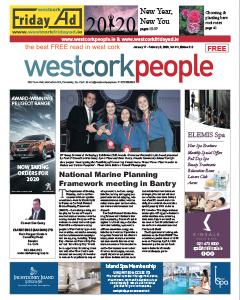From a farming perspective the last few weeks have been fantastic. Since the middle of December temperatures have consistently been between eight and 14 degrees Celcius. It’s perfect early season grass growing weather – the kind that farmers longed for most of April 2018.
In the last few weeks I saw daffodils flowering on New Year’s Day, sycamores budding in December and, to top it off, I saw a hedgehog crossing the road a few nights ago.
Just to put a downer on it, I think nature will balance this out and there is a long winter ahead yet.
Slurry-spreading season
Anyone driving through the countryside recently will tell you slurry-spreading season has reopened. It’s a job off the list here and it was unusual to go for the more challenging paddocks first. But with ground dry, a decision was made with the contractor to aim for the hillier paddocks and get them out of the way.
Calving season
Around West Cork, you can see more cows out grazing than would be normally seen at grass this early in the year. If weather holds up those numbers will grow as calving season moves into gear.
There are an extra 30,000 additional dairy calves expected this spring. This rise in numbers has been consistent since the abolition of milk quota in 2015. From 2016 to 2018 there have been an extra 64,000 calves born in the months of February and March.
This has led to an increase in demands on labour at farm level and also. To take pressure off farmers, Bandon mart will be holding a second weekly sale for calves. This venture will begin on the last Thursday in February.
Mart manager, Tom McCarthy explained the reasons behind it. “A lot of farmers were saying we have to try and help them in anyway that we can. Mondays are probably stretched to the limit, as it is we’re dealing with 1,500 to 1,700 calves at the peak sales, which is a long day on the calf and on the farmer.
“We’re going to try a second sale on Thursdays. We hope that this will take some of the pressure off farmers at peak calving time. Labour is scarce in yards and they’d like to move off calves as quick as possible.”
Some rule changes to the movements of calves came into effect at the start of February. One of the main ones is that calves can’t be moved before they are ten days old. That’s something farmers will have to watch because many have compact calving systems. This will see anywhere from 60 to 85 per cent of cows calve within a six week period.
Because of this, calf numbers will build up quickly in yards and farmers will want to move them quickly to reduce labour pressure. On the purchasing side Tom said: “All the buyers are happy with it as Thursdays are an export day. If exporters want to use it we have an export lairage here and they can export directly out of Bandon mart on the day. It has all the right ingredients so hopefully it will work.”
Exports
Live export of calves to the continent is a major outlet for Irish dairy calves however it is not always straightforward for a variety of reasons. An upcoming challenge will be lairage space at Cherbourg port in France. The lairage space is the area to rest calves when they arrive after the ferry crossing.
New rules could hamper the number of calves that can be exported during the peak of mid-March to mid-April. Veterinary rules state that calves ferried from Ireland must be rested, fed and watered for 12 hours at Cherbourg.
Currently the facilities in Cherbourg can handle 4,000 calves every 12 hours. This is the equivalent of 12 or 13 modern trucks
Until 2018, calves were rested in two approved lairages at Cherbourg or, if these were full, the next available one en route to Holland, Belgium, Italy and Spain.
However, welfare groups complained that some Irish calves, by travelling to the next available lairage, were exceeding maximum journey times.
As a result, for 2019 the Department of Agriculture will insist that all calves are rested at Cherbourg. So the new rules mean that no more than 13 lorries, or 4,000 calves in all, can stop there on any one day.
This will be adequate for most of the year but during the peak three or four weeks, exporters could send up to 20 lorries on a busy day. When there is stormy weather at sea, calf transport id suspended and this can cause a backlog.
In an ideal scenario, the 2019 sailings from Dublin to Cherbourg would alternate with Rosslare sailings, spreading out demand for the Cherbourg lairage. However, that will not be the case in February, March, April and early May.
This spring there will be three weekly sailings, on Tuesday, Thursday and Saturday, from Rosslare to Cherbourg. There will also be three weekly sailings from Dublin to Cherbourg on the same days.
The transport of calf trucks on ferryboats is strictly regulated on health and welfare. In lay persons’ terms, calves must have plenty of fresh air and be on a large, stable boat. Calf trucks can only be taken on board if forecast sailing weather is calm. Ferries also must have facilities to tie down trucks to ensure stability.
Milk Price
On the financial side for dairy farmers, Carbery maintained its base milk price for December milk, but has removed the 1cpl support payment, which it has been paying to its four shareholder co-ops over the past few months. Based on the November price, this would result in a December milk price of 31.8c/l excluding VAT. Neighboring co-op, Dairygold, announced that it will hold their December milk price at 30.36c/l excluding VAT.
Speaking at the Irish Grassland Associtaion dairy conference in Charleville, Carbery CEO, Jason Hawkins said he expects the milk supply coming into Carbery to continue to grow by three to four per cent per year.
Now over a year in the job, the Kerry native gave an assurance that they will continue to process all the milk that is offered to them and that if, as seems likely, extra processing capacity is needed in three to four years’ time, the cost of that extra capacity will be met from the group’s own resources and there will be no levy or other charges imposed on farmers.
CAP
I attended two meetings in West Cork regarding the upcoming CAP (Common Agricultural Policy) review. They were hosted by the IFA and Macra na Feirme to enable both organisations consult their members. Debate about the definition of a genuine farmer featured at the IFA meeting in Macroom, while environmental issues were raised by Macra members in Dunmanway. In all honesty it was a case of everyone trying to look after their own corner. One farmer I spoke to afterwards summed the proceedings up nicely: “Everyone was bringing their own bullocks to the fair”.
All the signals from Brussels are that there will be more of a focus on environmental issues in the next CAP. There was more awareness of this at the Macra event as younger farmers are more than likely going to have to farm to farm with more awareness of their environment if not increased environmental controls.
Redistribution of payments and retirement options were to the fore of farmers’ minds at the IFA event.
The historical reference years of 2000 to 2002 still rankle with some farmers, particularly those on lower payments, and this was made clear to IFA president Joe Healy in Macroom.
These farmers were wary about whether redistribution would happen and to what extent.
Generational renewal and the need for linking payments to some form of retirement option was a common denominator at both venues. It’s a subject that could warrant a meeting of its own, especially given the potential challenges ahead in some farming sectors and land types. At present, Brussels does not look favourably on a retirement scheme due to the long-term nature of it.
Part of the proposals from the EU includes each country defining what an active farmer will be. That will be another challenging debate for those involved. There was an appetite for using information available from previous Single Farm Payment applications to determine the activity levels of a farmer.
The final outcome on how EU funds will make their way to farmers and rural communities won’t be known for some time yet. The unknown entity of Brexit doesn’t help speeding up the proceedings either.
CAP thoughts will be more to the back of my mind than front and centre for the next while as activities within the farm boundary take over. The first calf isn’t due on the ground here for another month but preparations are under way. Cows are now getting pre-calving minerals and my priorities now are to get facilities on order. Fail to prepare, prepare to fail and all that.



